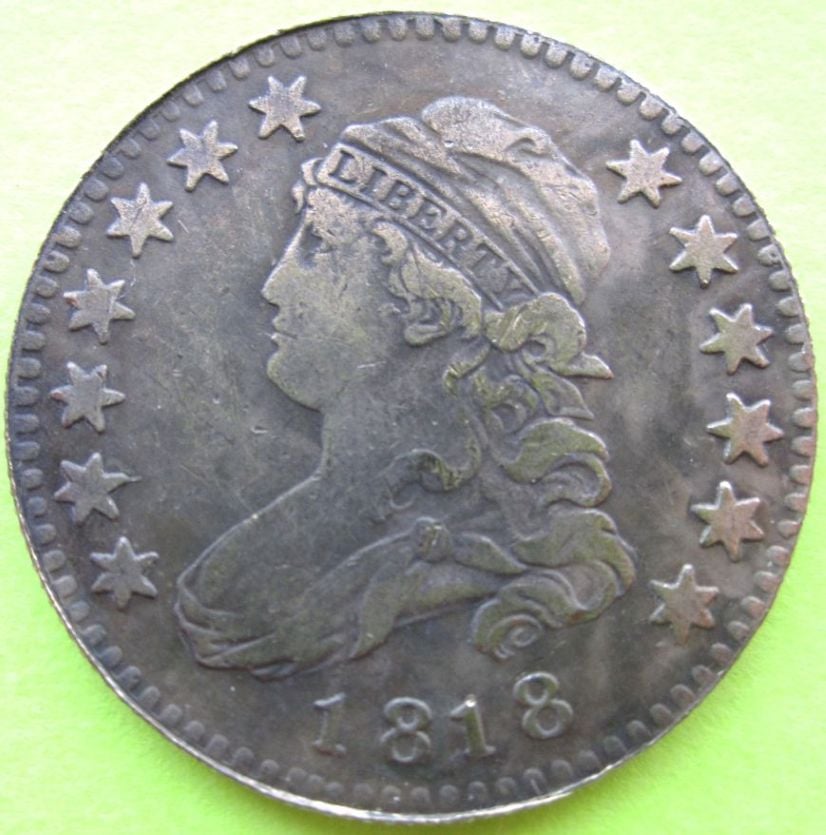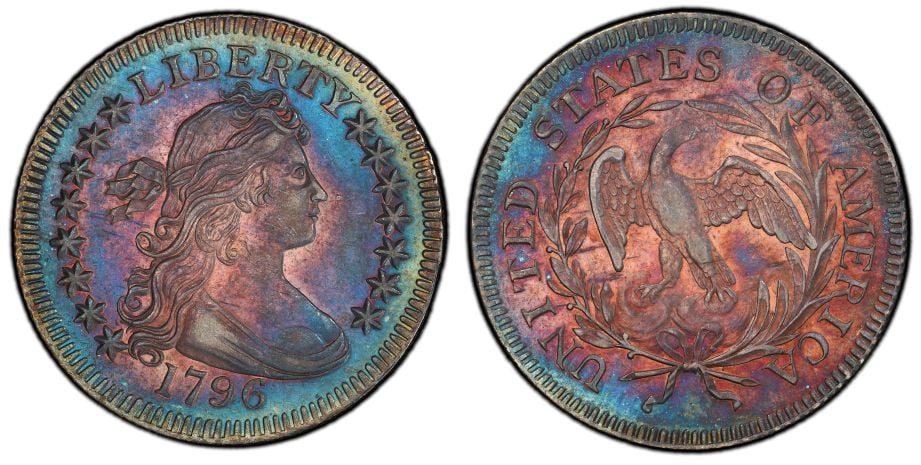1818 Capped Bust Quarter
 VanHalen
Posts: 4,330 ✭✭✭✭✭
VanHalen
Posts: 4,330 ✭✭✭✭✭
Greetings - I happened across this 1818 Capped Bust Quarter which is a counterfeit. I apologize for the images but they are good enough to see it's a fake. I don't think it would fool any of you though it might slide by the unsuspecting. Diameter is spot on 27.5 mm with a weight of 7.2 grams. Rims are upset and appear like what would be expected of a closed collar strike.
I am no expert on these and have a question: Were large diameter bust quarters open collar strikes? Comments are welcome. Thank you.

2
Comments
Large diameter Bust quarters (1796–1838) were struck using open collars, meaning the planchets weren't tightly confined during striking. This allowed the metal to spread more freely, resulting in slightly irregular shapes and larger diameters. Edge reeding was applied separately before striking using a Castaing machine. Closed collar technology, which produces more uniform, round coins with integrated reeding, wasn’t adopted until the late 1830s with the advent of steam-powered presses.
Proud follower of Christ!
Rim fins on a CB quarter?
"When they can't find anything wrong with you, they create it!"
I don't believe this is accurate. The castaing machine was only used for edge lettering. The reeding was applied during the strike of the coin.
"But seek ye first the kingdom of God and His righteousness and all these things shall be added unto you" Matthew 6:33. Young fellow suffering from Bust Half fever.
BHNC #AN-10
JRCS #1606
I thought the castaing applied the reeding. If there was no collar at striking there's no method to apply the reeding right?
I am far from an expert, most of my info was acquired this year. I wasn't sure about the strike type (open or closed) on large diameter quarters. Knowing for sure now they were open collar, I assumed the reeding had to be applied before striking.
.
Here is an article by a forum member (By Bradley S. Karoleff, NLG) that discusses the 'Castaing Machine'. I have set the page to the part where the discussion on the reeded edge kind of begins (4 pages remaining).
https://nnp.wustl.edu/library/book/568039?page=36
https://youtube.com/watch?v=hYCRaWPlTIE Sophie Lloyd, guitar shred cover of Panama (Van Halen)
https://youtube.com/watch?v=dOV1VrDuUm4 Ted Nugent, Hibernation, Live 1976
RLJ 1958 - 2023
Here is a quote from the article linked above:
_"Some, like the plain edges and the fully doubled edges are rare and others like the “Guidos” and partially edge lettered examples are relatively common. This will serve as a basis for proving that the Castaing machine was NOT used to impart the edge reeding on the minor coins of our early Mint.
The half dollars were the most abundant of our early silver coinages. It is not uncommon to find the edge errors I have described on these half dollars. What 1 have NEVER seen is one of these errors represented on a reeded edge coin of this time period."_
My personal observation of lower denomination silver coins confirmed to me that the edge reeding is applied during the strike. Weak reeding (still separated reeds, but flat spots on the high points) is commonly seen on edges, many times with one side heavier reeding than not. On the other hand, planchets for half dollars were tightly squeezed into the Castaing machine to leave a heavily impressed edge lettering design with largely upset rims to assist the design detail in the strike. There were no weaker sides to the edge lettering. This shows that our early lower denomination silver coins needed adequate diameter expansion to achieve complete reeding detail. While ideally the edge reeding was filled in to ultimate detail, production tolerances allowed for slightly weaker reeding to be seen on examples today.
"But seek ye first the kingdom of God and His righteousness and all these things shall be added unto you" Matthew 6:33. Young fellow suffering from Bust Half fever.
BHNC #AN-10
JRCS #1606
Thanks for your input I really appreciate it. I don't know the answer and you make good observations about Castaing andweakness of the rim reeding. I assumed the weakness was from wear combined with early quarters being slightly thinner than the later standardized closed collar strikes. It would be good to know exactly how the reeding was applied.
If your theory is correct (they were die struck) then one of the dies had to have reeding cut into the edges of it.
Not exactly. There are significant off center strikes that exist, which all lack edge reeding entirely. This would eliminate any theory that the collar is connected to either the obverse or reverse dies. The off centered coin would be severely damaged.
The early technology is not considered a closed collar strike, which explains the lack of rim fins on any early reeded edge type. The collar was a separate (likely single) piece from the obverse and reverse dies. The amount of space between the blank planchet and the collar was notable, which is why it is not a "closed collar" strike. So, it is still an "open collar" strike but the reeding is applied with a collar during the striking of the coin. Beyond this I do not know the specifics, because no First Mint equipment survives today.
According to the article, the U.S. Mint started using closed collar strikes in 1829.
"But seek ye first the kingdom of God and His righteousness and all these things shall be added unto you" Matthew 6:33. Young fellow suffering from Bust Half fever.
BHNC #AN-10
JRCS #1606
Again, thank you jacrispies. I'm intrigued with Draped Bust & Large diameter Capped Bust quarters and just ordered Browning's The Early Quarter Dollars of the United States. The size (27.5 mm) makes for easier viewing with my old eyes.
Someday I may own a 1796 example. This one would do nicely.
This one would do nicely.

In the book Early United States Quarters 1796-1838 Steve Tompkins provides an edge reed count by die marriage, where the edge reeds could be counted. The 1805 DM's had 115 edge reeds, in 1806 the edge collar was changed, and the count was 114 edge reeds. The edge collar was changed again in 1815, with 108 edge reeds until 1827.
This was known earlier with research done by Anthony Taraszka and Russ Logan, on Draped Bust eagles 1795-1804, which indicates a consistent edge reed count for certain years until the collar was changed. Also, the edge diameters were the same with each collar, proving the reeds were applied during the strike using an edge collar. The research was published in the article "Diameters and Edge Reed Counts of Early Eagles" by Taraszka in the July 1999 John Reich Journal (on NNP).
The Castaing edge lettering and rimming machine was used only for half dollars and dollars, and some early copper. The Castaing machine was ready very early at the Mint, with all early dollars and half dollars having edge lettering in 1794 and all subsequent years. Cents had earlier edge lettering than the silver. Henry Voigt may have had knowledge of an edge marking machine at the Saxony Mint, and the Castaing machine was described in detail and illustrated by Robert Scot in the March 1792 Philadelphia publication of Dobson's Encyclopædia, in which David Rittenhouse was a subscriber.
First here is the link to the article, "Diameters and Edge Reed Counts of Early Eagles" , on the NNP that Nysoto referenced above.
https://nnp.wustl.edu/library/book/529771?page=23
Found a link to this youtube video on the ANA website. Only 3 1/2 minutes but somewhat interesting as it attempts to best show how the bust coins were made and how going through the Castaing machine upsets the coin (you can see it deform).
Warning loud audio - turn down the volume.
 https://www.youtube.com/watch?v=NHDzdao-o74
https://www.youtube.com/watch?v=NHDzdao-o74
https://youtube.com/watch?v=hYCRaWPlTIE Sophie Lloyd, guitar shred cover of Panama (Van Halen)
https://youtube.com/watch?v=dOV1VrDuUm4 Ted Nugent, Hibernation, Live 1976
RLJ 1958 - 2023
As has been mentioned earlier by other posters, this is INCORRECT.
Let’s refer to the collars before the 1828 small date dime, 1829 half dimes, 1831 quarters and the corresponding gold coins as being in a LOOSE collar and the newer raised rim coins from a CLOSE collar. ALL coins with REEDED EDGES were struck IN COLLARS.
The Castaing machine only applied lettering to the edges of the planchets NEVER reeding.
Thanks to jacrispies for referencing my article from the JR Journal.
Happy to discuss further with anyone. Drop me a line.
Brad
A: The year they spend more on their library than their coin collection.
A numismatist is judged more on the content of their library than the content of their cabinet.